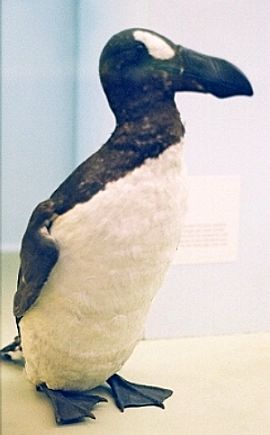 Credit: NHM, London.
Credit: NHM, London.
With a string of Hollywood smash hits about penguins and polar bears, more people than ever now know that polar bears live near the North Pole, and penguins live at the South Pole. Penguins not only just live at the South Pole--they thrive all throughout the Southern Oceans, from the South Pole to the Galapagos Islands . Last time, I had mentioned giant fossil penguins from Peru. These new fossils, in addition to those that are almost twice as old from New Zealand, tell us about the ancient history of penguins in the Southern Hemisphere. But why have penguins never made it to the Northern Hemisphere? If penguins were so wildly successful, in the their own peculiar lifestyle, why didn't they go global?
Looking around the Northern Hemisphere, we see plenty of skimming, plunging, and diving birds, but nothing penguin-like at all. Not so fast, though--one problem is our sense of time scale. Up until recent historical times, a very penguin-like, forelimb--swimming bird did live in the Northern Hemisphere: the Great Auk ( Pinguinus impennis). This bird, which was hunted to extinction in the mid 19th century, lived on rocky coasts of the North Atlantic Ocean, and looked very much like a penguin (its genus name even reflects the historical confusion too), and swam with its forelimbs too. Further back in time, from 3-11 million years ago, extinct relatives of the North Atlantic auks called mancallines lived in the North Pacific Ocean, and many fossils species have been recognized from California and Mexico. Going back even further in time, from 40 to 20 million years ago, another completely unrelated group of penguin-like seabirds lived in the North Pacific: the plotopterids. Their evolutionary relationships continue to be debated, but the anatomy of their forelimbs leave no doubt that plotopterids were penguin convergents, just like the convergence between placental and marsupial mammals.
The fossil record shows that plotopterids and the archaic giant penguins (like those in Peru) both went extinct about the same time that marine mammals emerged to become dominant marine predators, about 15-20 million years ago. The implication is that early relatives of sea lions and dolphins out competed plotopterids, but this idea doesn't explain the whole story because their southern convergents, penguins, continue to co-exist with marine mammals all throughout the Southern Oceans. Other factors, like ocean conditions and changes in sea level, might also have precipitated the demise of plotopterids; likewise, the onset of the Ice Ages might have also driven mancallines to extinction.
Living penguins, therefore, are the only reminder of this unique kind of seabird, and the penguin-like strategy is something that has been repeated several times by unrelated groups of seabirds, in both hemispheres. Pretty cool!
![]() Nick Pyenson is a PhD candidate at the University of California, Berkeley, in the department of integrative biology and the museum of paleontology.
Nick Pyenson is a PhD candidate at the University of California, Berkeley, in the department of integrative biology and the museum of paleontology.
